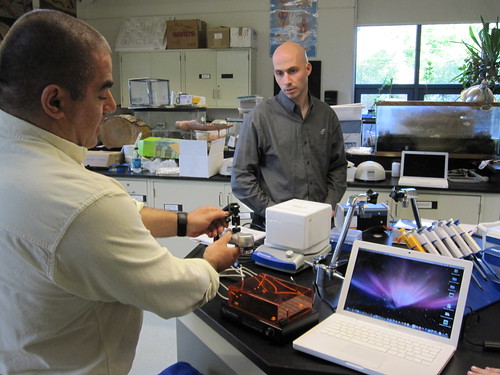
Image : http://www.flickr.com
Safety. Although the hazards in the following experiments are negligible, you are advised to consult the latest edition of 'Safeguards in the School Laboratory' published by The Association for Science Education (ase.org.uk) before embarking on any experiment.
Outline. Catalase is an enzyme which occurs in the cells of many living organisms. Certain of the energy-releasing reactions in the cell produce hydrogen peroxide as an end-product. This compound, which is toxic to the cell, is split to water and oxygen by the action of catalase. 2H2O2 = 2H2O + O2
Samples of liver and yeast are dropped into hydrogen peroxide. Oxygen is evolved and the student is asked to extend the experiment to try and decide if an enzyme in the tissues is responsible. The experiments and the questions take about one hour.
Prior knowledge. The existence of inorganic catalysts; enzymes denatured on boiling; oxygen relights a glowing splint.
Advance preparation and materials - per group
20 volume hydrogen peroxide 50 cm3
splint
liver, about 1 cm cube
distilled water 20 cm3
dried yeast about 1 g
clean sand about 1 g
activated charcoal granules, about 1 g
Apparatus - per group
test-tube rack and 4 test-tubes
forceps or seeker for pushing liver into test-tube
4 labels or spirit marker
filter funnel
Bunsen burner
filter paper
test-tube holder
mortar and pestle
Experiment
The investigation below is a fairly critical examination of plant and animal tissues to see if
they contain catalase.
(a) Label three test-tubes 1-3.
(b) Pour about 20 mm (depth) hydrogen peroxide into each tube.
(c) Cut the liver into 3 pieces.
(d) To tube 1 add a small piece of liver, and to tube 2 add a pinch of dried yeast.
(e) Insert a glowing splint into tubes 1 and 2, bringing it close to the liquid surface or into the upper part of the froth.
1 Describe what you saw happening and the effect on the glowing splint.
2 How do you interpret these observations?
3 Is there any evidence from this experiment so far, to indicate whether the gas is coming from the hydrogen peroxide or from the solid?
4 Is there any evidence at this stage that an enzyme is involved in the production of gas in this reaction?
(f) In tube 3 place a few granules of charcoal and observe the reaction.
5 Could charcoal be an enzyme? Explain your answer.
6 Assuming (i) that the gas in (f) is the same as before and (ii) that the charcoal is almost pure carbon, does the result with charcoal help you to decide on the source of the gas in this and the previous experiments?
(g) Suppose the hypothesis is advanced that there is an enzyme in the liver and yeast, which decomposes hydrogen peroxide to oxygen and water; design and carry out a control experiment to test this hypothesis.
7 Record (i) the experiment, (ii) the reasons which led you to conduct it, (iii) the observed
results and (iv) your conclusions.
(h) Wash out the test-tubes. Design and carry out an experiment to see if the supposed enzyme in the plant and animal material can be extracted and still retain its properties. The experiment should include a control.
8 Describe briefly your procedure, your results and your conclusions.
9 Assuming that liver and yeast each contain an enzyme which splits hydrogen peroxide, is there any evidence to show that it is the same enzyme? What would have to be done to find this out for certain?
Discussion - answers
1 Effervescence should be observed in each case but it is more vigorous with yeast than with liver. The glowing splint should relight.
2 Oxygen is being produced.
3 There is no evidence to indicate whether the liquid or solid is giving the gas. If the students think that a solid is unlikely to give off a gas they could be reminded of marble and hydrochloric acid in which it is the solid producing the carbon dioxide. It seems less likely, however, that yeast and liver would both give off oxygen when treated with hydrogen peroxide, than that hydrogen peroxide should give oxygen when treated with diverse substances.
4 So far, there is no evidence of an enzyme being involved.
5 A gas will come off but not sufficiently rapidly to relight a glowing splint. Charcoal could not
be an enzyme because (a) it is an element and (b) it has been produced by very high temperatures that would destroy enzymes.
6 Charcoal, as an element, could not be giving off oxygen. The gas must be coming from the
hydrogen peroxide.
7 (i) The experiment should involve boiling the tissues and then putting them into hydrogen peroxide.
(ii) If an enzyme is involved,
(iii) no gas will be produced.
8 The student should grind the samples with a little sand and distilled water, filter and test the filtrate with hydrogen peroxide. Oxygen will be evolved with a vigour proportional to that witnessed when the original substances were tested.
The student should boil half of each extract and show that it loses its activity.
9 There seems no fundamental reason why yeast and liver should not have different enzymes which catalyse the decomposition of hydrogen peroxide. To be certain on this point, the enzymes would have to be extracted and their chemical composition determined.
D G Mackean is the author of GCSE Biology, IGCSE Biology, and many other Biology text books. He has a site of Biology Teaching Resources at http://www.biology-resources.com which includes a bank of experiments for teachers, sample PowerPoint presentations, and many biological drawings
No comments:
Post a Comment